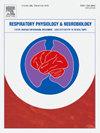Modulating respiratory mechanics and inflammation in hepatopulmonary syndrome: Aerobic exercise as a therapeutic strategy
IF 1.6
4区 医学
Q3 PHYSIOLOGY
引用次数: 0
Abstract
Introduction
Aerobic exercise training positively modulates the immune system and improves lung function; however, its effects on respiratory system’s elastic, resistive properties and interleukin-10 (IL-10) concentration in hepatopulmonary syndrome (HPS) remains unexplored. This study aimed to assess whether moderate-intensity aerobic (AE) training altered exercise capacity, respiratory mechanics and lung inflammation.
Material and methods
Wistar rats were randomly assigned to SHAM, HPS, HPS + AE4, and HPS + EA8 groups. The EA4 group represents AE training for 4 weeks starting 7 days after HPS induction, whereas EA8 accounts for AE training for 4 weeks before and after HPS induction, both protocols practiced 3 times weekly. Exercise capacity, respiratory mechanics, lung and systemic inflammation, and lung morphology were assessed.
Results
Moderate aerobic exercise significantly increased the maximal running capacity of the HPS animals. The training decreased tissue elastance by 19 % (p = 0.01 compared to SHAM) and reduced frequency-dependent respiratory reactance at 0.5 Hz, 0.75 Hz, and 1.25 Hz frequencies compared to HPS animals (p < 0.05 for all). For the HPS + EA4 and HPS + EA8 groups IL-10 plasma concentration increased by 23 % and 31 % compared to SHAM (p < 0.001 both) and by 38 % and 47 % compared to HPS (p < 0.01 both). Nonetheless, AE did not alleviate lung tissue remodeling induced by HPS.
Conclusions
Moderate-intensity aerobic training improved maximum running capacity, reduced HPS-induced respiratory mechanics derangements at the lung regional level, and increased systemic IL-10 concentration, although it did not ameliorate lung tissue remodeling.
调节呼吸机制和肝肺综合征的炎症:有氧运动作为一种治疗策略
有氧运动训练积极调节免疫系统,改善肺功能;然而,其对肝肺综合征(HPS)患者呼吸系统弹性、抵抗性和白细胞介素-10 (IL-10)浓度的影响尚不清楚。本研究旨在评估中等强度有氧(AE)训练是否会改变运动能力、呼吸力学和肺部炎症。材料与方法将swistar大鼠随机分为SHAM组、HPS组、HPS + AE4组和HPS + EA8组。EA4组为HPS诱导后第7天开始的4周AE训练,EA8组为HPS诱导前后4周AE训练,两组均为每周3次。评估运动能力、呼吸力学、肺部和全身炎症以及肺部形态。结果适度有氧运动可显著提高HPS大鼠的最大跑能力。与SHAM相比,训练使组织弹性降低了19% % (p = 0.01),并且与HPS动物相比,在0.5 Hz, 0.75 Hz和1.25 Hz频率下,训练降低了频率依赖性呼吸电抗(p <; 0.05)。为HPS + EA4和HPS + EA8组il - 10血浆浓度增加了23 31 %和%比虚假的(p & lt; 0.001)和由38 %和47 % HPS相比(p & lt; 0.01)。然而,AE并没有减轻HPS引起的肺组织重构。结论中等强度有氧训练可提高最大运动能力,降低hps引起的肺区域呼吸力学紊乱,增加全身IL-10浓度,但不能改善肺组织重塑。
本文章由计算机程序翻译,如有差异,请以英文原文为准。
求助全文
约1分钟内获得全文
求助全文
来源期刊
CiteScore
4.80
自引率
8.70%
发文量
104
审稿时长
54 days
期刊介绍:
Respiratory Physiology & Neurobiology (RESPNB) publishes original articles and invited reviews concerning physiology and pathophysiology of respiration in its broadest sense.
Although a special focus is on topics in neurobiology, high quality papers in respiratory molecular and cellular biology are also welcome, as are high-quality papers in traditional areas, such as:
-Mechanics of breathing-
Gas exchange and acid-base balance-
Respiration at rest and exercise-
Respiration in unusual conditions, like high or low pressure or changes of temperature, low ambient oxygen-
Embryonic and adult respiration-
Comparative respiratory physiology.
Papers on clinical aspects, original methods, as well as theoretical papers are also considered as long as they foster the understanding of respiratory physiology and pathophysiology.

 求助内容:
求助内容: 应助结果提醒方式:
应助结果提醒方式:


